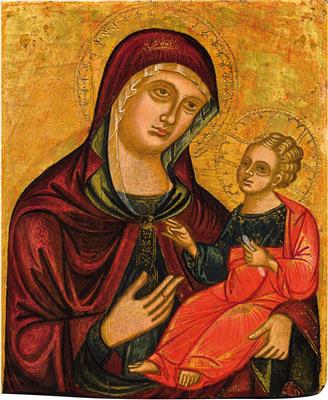Circle of Catarino da Venezia

(active in Veneto 1362–1390)
Madonna and Child,
tempera on panel, gold ground, 25.7 x 21.3 cm, unframed
Provenance:
Collection Gustav Adolf Spengler (1869-1961), Osnabrück, Lower Saxony,1926;
Private Collection, Hannover;
Private European Collection
The present picture is a devotional painting, executed for private devotion. The gold background appears to reveal in part the preparatory layer beneath.
The work is an example of the neo-Byzantine trend in Venetian painting of the late 14th century, in the manner of Stefano di Sant’Agnese, Guglielmo Veneziano, Donato and Catarino da Venezia and the image combines Venetian and Byzantine stylistic elements with elegance and great pictorial subtlety to reveal a variant of the famous iconographic type of the Hodegetria: the Madonna in half-length wears a purple-coloured maphorion lined with blue over a green robe hemmed with gold. With her right hand, she points at the Child depicted in red gown highlighted with golden streaks, holding a scripture-bearing scroll in his left hand, the other outstretched in a gesture of blessing. On the gold ground, we find traces of the inscriptions in red of the Greek letters of the monograms of the Theotokos: the Mother of God (MP OY), and Christ (IC XC).
The linear drapery and the sinuous contours appear Gothic in manner, while the typology of the figures and the accentuated stress of the shadows reveals the painter’s direct knowledge of the Palaiologan Byzantine style. The decoration of the halos with small punched arches is a clear Venetian derivation, found, for example, in the triptych of the Madonna and Child with Saints Nicholas and Francis in the Archdiocese Church of Pieve di Cadore, attributed to Catarino Veneziano (see: M. Lucco, Pittura del Duecento e del Trecento nelle Province Venete, in La Pittura in Italia. Il Duecento e il Trecento, Milan 1986, vol. I, pp. 143-44).
The present work may be compared to other works from the Venetian School of the late 14th century, including the polyptych in the Gallerie dell’Accademia, Venice, of the Coronation of the Virgin and eight Stories of Christ, attributed to an unknown follower of Catarino active around 1380 (see: R. Pallucchini, La Pittura Veneziana del Trecento, Venice-Rome, 1964, pp. 213-14) and a portable triptych whose whereabouts are unknown (Sotheby’s Monaco, 29th November 1986, lot 301) probably of a later date, whose central panel depicts the Mystical Marriage of Saint Catherine of Alexandria and various figures of saints in niches.
18.10.2016 - 18:00
- Prezzo realizzato: **
-
EUR 25.000,-
- Stima:
-
EUR 20.000,- a EUR 30.000,-
Circle of Catarino da Venezia
(active in Veneto 1362–1390)
Madonna and Child,
tempera on panel, gold ground, 25.7 x 21.3 cm, unframed
Provenance:
Collection Gustav Adolf Spengler (1869-1961), Osnabrück, Lower Saxony,1926;
Private Collection, Hannover;
Private European Collection
The present picture is a devotional painting, executed for private devotion. The gold background appears to reveal in part the preparatory layer beneath.
The work is an example of the neo-Byzantine trend in Venetian painting of the late 14th century, in the manner of Stefano di Sant’Agnese, Guglielmo Veneziano, Donato and Catarino da Venezia and the image combines Venetian and Byzantine stylistic elements with elegance and great pictorial subtlety to reveal a variant of the famous iconographic type of the Hodegetria: the Madonna in half-length wears a purple-coloured maphorion lined with blue over a green robe hemmed with gold. With her right hand, she points at the Child depicted in red gown highlighted with golden streaks, holding a scripture-bearing scroll in his left hand, the other outstretched in a gesture of blessing. On the gold ground, we find traces of the inscriptions in red of the Greek letters of the monograms of the Theotokos: the Mother of God (MP OY), and Christ (IC XC).
The linear drapery and the sinuous contours appear Gothic in manner, while the typology of the figures and the accentuated stress of the shadows reveals the painter’s direct knowledge of the Palaiologan Byzantine style. The decoration of the halos with small punched arches is a clear Venetian derivation, found, for example, in the triptych of the Madonna and Child with Saints Nicholas and Francis in the Archdiocese Church of Pieve di Cadore, attributed to Catarino Veneziano (see: M. Lucco, Pittura del Duecento e del Trecento nelle Province Venete, in La Pittura in Italia. Il Duecento e il Trecento, Milan 1986, vol. I, pp. 143-44).
The present work may be compared to other works from the Venetian School of the late 14th century, including the polyptych in the Gallerie dell’Accademia, Venice, of the Coronation of the Virgin and eight Stories of Christ, attributed to an unknown follower of Catarino active around 1380 (see: R. Pallucchini, La Pittura Veneziana del Trecento, Venice-Rome, 1964, pp. 213-14) and a portable triptych whose whereabouts are unknown (Sotheby’s Monaco, 29th November 1986, lot 301) probably of a later date, whose central panel depicts the Mystical Marriage of Saint Catherine of Alexandria and various figures of saints in niches.
|
Hotline dell'acquirente
lun-ven: 10.00 - 17.00
old.masters@dorotheum.at +43 1 515 60 403 |
| Asta: | Dipinti antichi |
| Tipo d'asta: | Asta in sala |
| Data: | 18.10.2016 - 18:00 |
| Luogo dell'asta: | Wien | Palais Dorotheum |
| Esposizione: | 08.10. - 18.10.2016 |
** Prezzo d’acquisto comprensivo dei diritti d’asta acquirente e IVA
Non è più possibile effettuare un ordine di acquisto su Internet. L'asta è in preparazione o è già stata eseguita.
